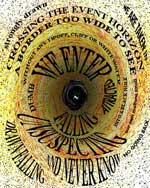|
Tending Toward the Untamed: Artists Respond to the
Wild Garden, at Glyndor House,
Wave Hill in the
Bronx, from April 3 to August 19, 2012.
This is a
rich and thought provoking exhibition that
includes a visit to Wave Hill's Wild Garden, and
highlights the work of eight artists who use
technology, new media, and traditional
representation. Paths through both Gallery and
Garden are well worth exploring and then
re-visiting as the experience builds on itself.
Inspired by the horticultural aesthetic of late
Victorian garden designer, William Robinson
(1838-1935), the Wild Garden is envisioned as the
kind of landscape one might encounter in nature.
However, watching the Wave Hill gardeners at work,
it becomes clear that this plot of nature doesn't
exist in a pristine state. Flowers and plants
from disparate parts of the world have been
carefully selected for their hardiness, cosseted,
and tamed into a semblance of wildness. They are
encouraged to mingle in improbable proximity,
bloom in untidy profusion, and settle in random
niches to work their poetic enchantment. In the
fragrant air, whatever the weather, a ramble
through the garden intoxicates the senses. One
must return to the gallery to sober up.

|
|
Isabella Kirland: Palisades
|
Beginning with with traditional media, Isabella
Kirkland presents the garden in full spring mode.
Her attention to botanical detail in "Palisades"
2012, recalls the precision of Dutch still-lives,
and late medieval art. Small ink and watercolor
studies of various plants and flowers accompany a
large oil painting depicting the garden as a
utopia on the Hudson where the endangered fauna of
New York State live safely among the flora.
Kirkland has a scientific background and
ambivalence about human intervention is implicit
in her idealized image. Noting the palisades in
the background, one thinks of the Hudson River
School, and the Transcendental movement in the
19th century when the natural world was being
blindly consumed for profit even as it was
elevated to the divine. The late 20th century
brought a growing awareness that the environment
was under stress, and by the 21st century the
concern that we may have done too much damage
already has become firmly established among
scientists. Kirkland's work poses the question,
"If we left nature alone, could it still restore
itself?"
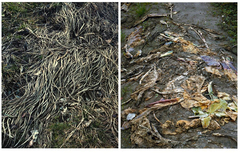
|
|
Janelle Lynch: Garden Remains
|
As a counterpoint to Kirkland's Edenic images,
Janelle Lynch's somber, sharply focused inkjet
prints remind us that we should never lose sight
of nature's imperatives lest we forget what we
are. Finding poetry in the natural disorder of
the compost heap, her photographs of fallen stalks
and moldering leaves, "Garden Remains" 2012, limn
the graphics of dynamic decay. In A Pilgrim at
Tinker Creek, Annie Dillard wrote, "The new is
always present with the old, however hidden." Like
Dillard, Lynch respects the utter seriousness of
the natural cycle — grim but for the fact that this
year's detritus nurtures next year's growth.
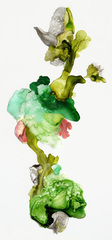
|
|
Julie Evans: Wild Garden
|
In contrast to the works of Lynch and Kirkland,
"Wild Garden" 2011, Julie Evans' wall
installation, is an internalized garden. Evans
masters the chaotic in her control and abandon,
exploiting the natural properties of water-based
media as it blooms and flows on Mylar. Lifting
and collaging the result, she builds semblances of
botanical forms into images of wild, efflorescent
beauty.
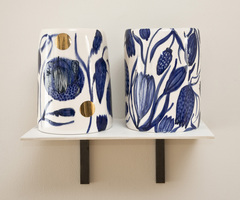
|
|
Anat Shiftan: Garden Views Series 2012
|
Anat Shiftan's "Garden Views" 2012, a series of
cool, modern vessels, are Zen-like in their
detachment from the turmoil of growth and decay.
Her porcelain cylinders are painted with
botanically correct interpretations of the
garden's plants as they cycle through the seasons.
A number of her pieces are displayed throughout
the exhibition. Only one, in the last room, is
asymmetrical--a thread, perhaps, connecting the
rustic nature of the wild garden to the
traditional Japanese Wabi-Sabi movement where
simplicity, transience and imperfection are
necessary components of aesthetic appreciation.
Erik Sanner's two videos in the next room could
stand as metaphors for light and its relationship
to art and photosynthesis--there is no garden, no
photographic image and no painting possible
without illumination. In order to capture
different perspectives of the garden and document
the seasonal changes, Sanner uses film gathered
from timed hunting cameras he had mounted around
the perimeter.

|
|
Erik Sanner: The Pixilated Garden (detail)
|
For "The Pixilated Garden" 2012,
the low-resolution film is projected onto a grid,
with a result that suggests light filtering
through leaves or scintillating on water. Nature,
always a participant at Glyndor Gallery, resonates
with this work situated on the west-facing wall.
The Hudson River views through the windows on
either side create a thoughtful correspondence
between the digital and the real.
Sanner's second installation, "The Painted Garden"
2012, shows a video of the artist's hands painting
the garden. This video is superimposed on the
painted panels and its flickering action makes the
painting's tactile surface scintillate like its
companion piece. It's a work of modern
impressionism that pulls in strands of Monet and
his garden at Giverny: the action of light on
pigment and the creation of form with light
affirming illumination as the essence of both
photography and painting
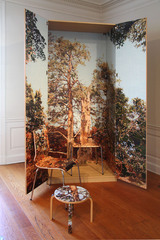
|
|
Gary Carsley: Wave Hill Tree Struck by Lightning
|
In an interesting curatorial loop, Gary Carsley's
hyperreal installation, "D.100, Wave Hill Tree
Struck by Lightening" 2012, references Kirkland's
photorealistic vision of the wild garden. Where
Kirkland imagines a restoration of the natural
world, Carsley's idea of the garden demonstrates
ambivalence toward the possibility. Carsley uses
artificial marquetry--faux wood-grain finishes and
Photoshop--to create an intricately worked
portrait of the garden for the interior of a
mass-produced cabinet. Yet, the central figure in
his glorious photographic compilation is a
lightening-blasted tree. This is an "IKEA"
studiolo, a renaissance memory closet complete
with chairs and a stool — where a modern humanist
can repair to consider the philosophical
implications of taming nature within and without.
It could also be the simulacrum of a medieval
enclosed garden, a domesticated ritual space with
an unspoken invitation to enter, meditate on the
subjugation of nature, and receive wisdom. Not
only are connections made to the idea of beauty
purposed with utility as championed by William
Robinson and the British Arts and Craft movement,
but to medieval and renaissance contemplative
traditions, and to the science fiction of Philip
K. Dick, where the only real interaction with the
natural is virtual.
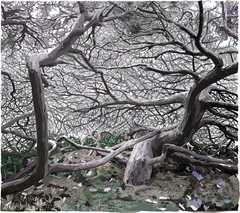
|
|
Chris Doyle: Interleaves
|
The title of Chris Doyle's two-screen custom
display, "Interleaves" 2012, suggests an open
book, but he also puts a new spin on the familiar.
Doyle examines the structure of the garden through
a series of photographs and drawings that he later
reworked and animated. In a mesmerizing loop of
visual information, Doyle's digitally manipulated
images merge, contort, change and return to their
original state. His intent, to bring our attention
to the way human anxieties and collective
attitudes are projected on to the environment, is
curiously at odds with the pleasurable viewing
experience. His illumined piece suggests a
futuristic breviary — offering pleas to care for the
environment or prayers for a remembered Nature.

|
|
Rebecca Morales: Seral
|
Finally, Rebecca Morales draws us back into the
imagined garden with "Seral" 2012. At once
medieval and modern, she paints on vellum, the
traditional material of illuminated manuscripts.
Creating a tightly packed image, Morales depicts
lichen, mosses, and other humble but necessary
plants, interwoven with images of manufactured
fabrics, knitted yarn, embroidery and lace. Then
she documents her work, brilliantly deconstructing
the dense layers of information in an accompanying
video. Leavened with light and air, the original
is released from materiality. The result becomes
an art form in itself, and a revelation of the
artist's process as she grows the work.
The exhibition could be seen, among other things,
as a path through an interior landscape where the
artists mirror the gardener's process of
selection, idealizing and featuring or removing
elements in their interpretive responses to the
wild garden. There are metaphorical leaps in the
curatorial choices and conceptual links to other
artistic and horticultural conventions. The
exhibition confronts concerns about the ethics of
human intervention and raises questions about what
it means to tame nature in the 21st century. In
the end, the artists' have recorded their
perceptions of nature and refashioned them into
evocative images, alerting us to issues that we
need to take in and address collectively.
 Catalog of the Exhibition Catalog of the Exhibition
|

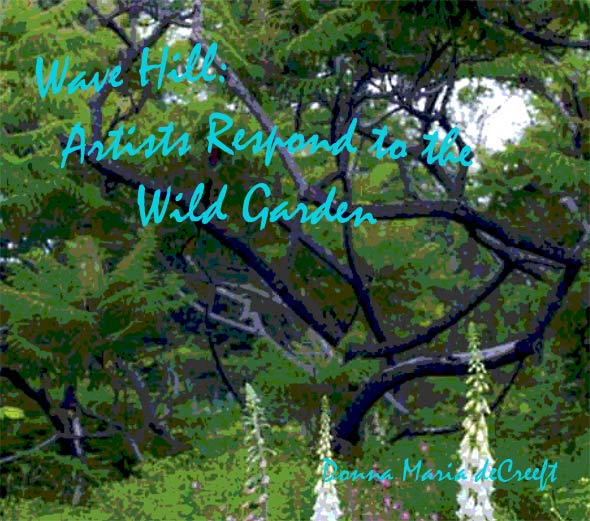







 Catalog of the Exhibition
Catalog of the Exhibition